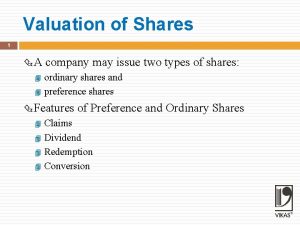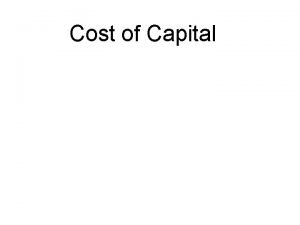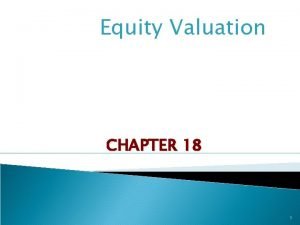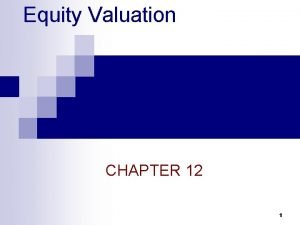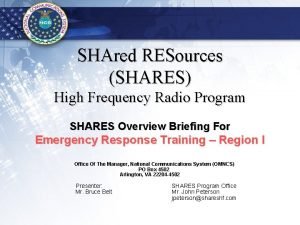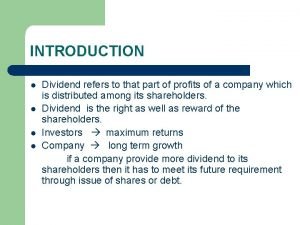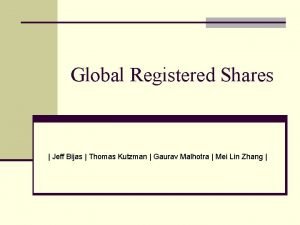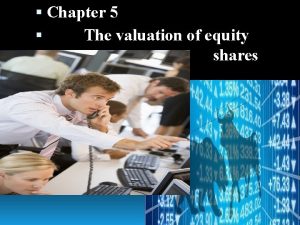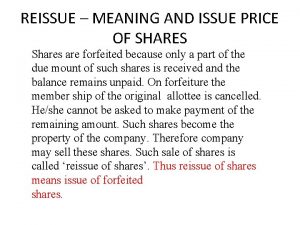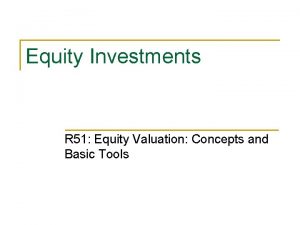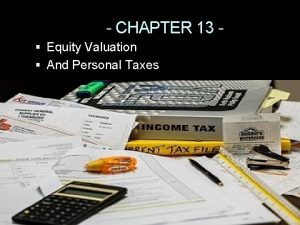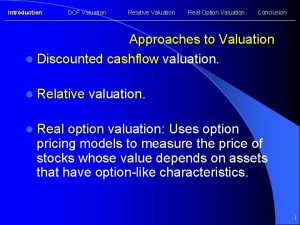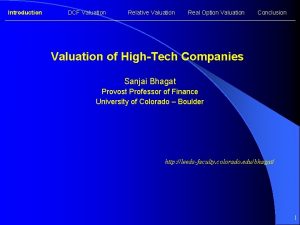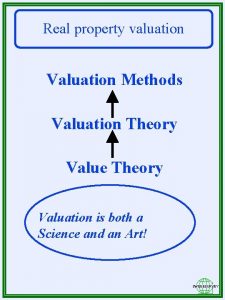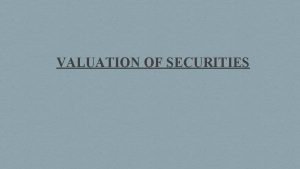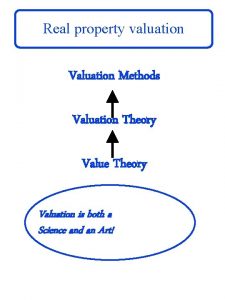VALUATION OF SHARES AND OTHER EQUITY IN THE























- Slides: 23

VALUATION OF SHARES AND OTHER EQUITY IN THE FINANCIAL ACCOUNTS OF THE SPANISH ECONOMY (FASE). The use of discounted value of future profits for unquoted non-financial public limited companies Begoña Gutiérrez del Olmo Moreda Statistics and Central Balance Sheet Data Office Department Specialist TASK FORCE ON THE VALUATION AND MEASUREMENT OF EQUITY (TFVME) Ottawa, Canada 13 April 2005 ECONOMICS, STATISTICS AND RESEARCH

VALUATION OF SHARES AND OTHER EQUITY IN THE FASE. The use of discounted value of future profits for unquoted non-financial public limited companies Contents 1. Introduction to the Spanish valuation methods: Description and aggregates 1. Issues of resident units 2. Issues of non-resident units held by residents 2. Discounted value of future profits (method D): Conceptual framework § References to the method in the SNA 1993 and in the ESA 95 § Reasons for applying method D as an alternative to method C § Requirements for applying method D 3. Description of method D § Definitions § Process of grossing up § A particular case: Companies systematically reporting losses Economics, Statistics and Research Department 2

INTRODUCTION TO SPANISH VALUATION METHODS: DESCRIPTION AND AGGREGATES General criteria Market valuation in strict sense Approximations to market valuation Book value Economics, Statistics and Research Department Issues of residents Specific criteria Aggregates Market capitalisation (A) Quoted public limited companies (Non-financial and banks) Net asset value (B) Mutual Funds Capitalisation / Own funds ratio (C) Unquoted banks Discounted value of future profits (D) Unquoted non-financial public limited companies Own funds (E) Unquoted public limited companies (Financial except banks) Other legal forms (Other equity) 3

INTRODUCTION TO SPANISH VALUATION METHODS: DESCRIPTION AND AGGREGATES Issues of non-residents held by residents (F) Valuation methods based on: – Market value: In case of quoted shares – International Investment Position Statistics: In other cases Economics, Statistics and Research Department 4

VALUATION OF SHARES AND OTHER EQUITY IN THE FASE. The use of discounted value of future profits for unquoted non-financial public limited companies Contents 1. Introduction to Spanish valuation methods: Description and aggregates 1. Issues of resident units 2. Issues of non-resident units held by residents 2. Discounted value of future profits (method D): Conceptual framework § References to the method in the SNA 1993 and in the ESA 95 § Reasons for applying method D as an alternative to method C § Requirements for applying method D 3. Description of method D § Definitions § Process of grossing up § A particular case: Companies systematically reporting losses Economics, Statistics and Research Department 5

DISCOUNTED VALUE OF FUTURE PROFITS (METHOD D): CONCEPTUAL FRAMEWORK § § References to the method in the 1993 SNA and in the ESA 95 1993 SNA: – (13. 28): “…market prices may be approximated by the present, or discounted, value of future economic benefits expected from a given asset; this is the case for a number of financial assets, natural assets and intangible assets…” – (13. 34): “…although normal prices are used to value the ultimate output, a rate of discount must, in addition, be used to compute the present value of the expected future returns…” ESA 95: – (7. 27): “…In addition to prices observed on markets or estimated from observed prices or costs incurred, current prices may be approximated for balance sheet valuation by: a)… b) the present, or discounted, value of future returns” Economics, Statistics and Research Department 6

DISCOUNTED VALUE OF FUTURE PROFITS (METHOD D): CONCEPTUAL FRAMEWORK Reasons for applying method D (as an alternative to method C) Why does Spain use an alternative method? § Only in the case of banks are unquoted companies well represented by quoted ones § Unquoted non-financial public limited companies are not well represented by quoted ones because quoted public limited companies, –are usually larger than unquoted ones –usually have a different financial structure from unquoted companies –are concentrated among particular economic activities which usually demand a larger volume of funds –The number of quoted public limited companies is very small relative to the total § Method D is the most commonly used by financial analysts Economics, Statistics and Research Department 7

DISCOUNTED VALUE OF FUTURE PROFITS (METHOD D): CONCEPTUAL FRAMEWORK Reasons for applying method D (as an alternative to method C) Some figures to measure the problem Economics, Statistics and Research Department 8

DISCOUNTED VALUE OF FUTURE PROFITS (METHOD D): CONCEPTUAL FRAMEWORK Reasons for applying method D (as an alternative to method C) The problems of using multi-country ratios Additional limitations arise when trying to use multi-country ratio data because of the differences between countries’ financial structures 1. Some of these differences are: 1. 2. 3. 4. 5. 6. 7. 8. The amount and the structure of assets Revaluation criteria Financing practice in each country Relationships between firms and banks Tax systems Guarantees offered to lenders Pensions Bankruptcy law insolvency rules (1) According to the conclusions of the Own funds Working Group of the European Committee of Central Balance Sheet Data Offices set out in one of its studies Economics, Statistics and Research Department 9

DISCOUNTED VALUE OF FUTURE PROFITS (METHOD D): CONCEPTUAL FRAMEWORK Reasons for applying method D (as an alternative to method C) Quoted and unquoted companies: Some European figures Economics, Statistics and Research Department 10

DISCOUNTED VALUE OF FUTURE PROFITS (METHOD D): CONCEPTUAL FRAMEWORK § Requirements of the method The application of this method requires: 1. A quality data source for non-financial companies’ profit and loss accounts to estimate future profits to be discounted 2. A market reference to estimate the discounting rate 3. Demographic statistics for non-financial companies § In Spain the information comes from: § § Central Balance Sheet Data Office Database: Accounting information and a conversion table to go from business accounting to National accounts National demographic statistics for corporations: DIRCE from National Institute of Statistics Economics, Statistics and Research Department 11

VALUATION OF SHARES AND OTHER EQUITY IN THE FASE. The use of discounted value of future profits for unquoted non-financial public limited companies Contents 1. Introduction to Spanish valuation methods: Description and aggregates 1. Issues of resident units 2. Issues of non-resident units held by residents 2. Discounted value of future profits (Method D): Conceptual framework § References to the method in the SNA 1993 and in the ESA 95 § Reasons for applying method D as an alternative to method C § Requirements for applying method D 3. Description of method D § Definitions § Process of grossing up § A particular case: Companies systematically reporting losses Economics, Statistics and Research Department 12

DISCOUNTED VALUE OF FUTURE PROFITS (METHOD D): DESCRIPTION OF THE METHOD § This method estimates the market value of shares issued by unquoted firms by calculating the present value of the future profits generated by such firms § The method is based on the fact that the market value of quoted firms can be obtained by dividing their expected profits by a discount factor Risk-free interest rate Risk premium Where RONc is the expected profit for the following year, and dc is the implicit discount factor § Expected growth rate of profits Underlying this method is the hypothesis that the profits generated by such firms are considered to be perpetual. Economics, Statistics and Research Department 13

DISCOUNTED VALUE OF FUTURE PROFITS (METHOD D): DESCRIPTION OF THE METHOD § Likewise, the following expression can be deduced for unquoted shares: Economics, Statistics and Research Department 14

DISCOUNTED VALUE OF FUTURE PROFITS (METHOD D): DESCRIPTION OF THE METHOD Definitions RON (Ordinary Net Profit) § Ordinary Net Profit is defined as: Economics, Statistics and Research Department 15

DISCOUNTED VALUE OF FUTURE PROFITS (METHOD D): DESCRIPTION OF THE METHOD Definitions RON (Ordinary Net Profit) § RONnc is calculated, company by company in the database, as the weighted average of the ordinary net profit over the last five years, as follows: Economics, Statistics and Research Department 16

DISCOUNTED VALUE OF FUTURE PROFITS (METHOD D): DESCRIPTION OF THE METHOD § Definitions: dnc is defined as : Where, – dc is the discount rate associated with quoted shares – 0. 03 is the illiquidity premium. This premium should consider not only the illiquidity but, also, the possibility that unquoted public limited companies’ profits are not as perpetual as those of quoted ones. Therefore, an increase in the discount rate, because of the different time horizons, must be considered The level of this premium has been quantified according to theoretical analysis of the gap between perpetual income and temporary income Economics, Statistics and Research Department 17

DISCOUNTED VALUE OF FUTURE PROFITS (METHOD D): DESCRIPTION OF THE METHOD Definitions: dnc § dc is calculated as the median of the discount rates of all the quoted non-financial corporations traded on the continuous market, which means excluding floor-traded companies § Extremely volatile corporations are stripped out of the aggregate by means of the trust interval, which is defined as the average plus/minus twice the standard deviation. § Sector differentiation is only applied in the case of the electricity sector because of its specific features Economics, Statistics and Research Department 18

DISCOUNTED VALUE OF FUTURE PROFITS (METHOD D): DESCRIPTION OF THE METHOD § Definitions: dnc The discount factor obtained by this method is as follows: Economics, Statistics and Research Department 19

DISCOUNTED VALUE OF FUTURE PROFITS (METHOD D): DESCRIPTION OF THE METHOD Process of grossing up § The Central Balance Sheet Data Office Database provides information on approximately 30, 000 unquoted public limited companies § Using the conversion table which allows one to go from business accounting to National Accounts, a full chart of accounts, including those relating to other changes in volume and revaluation, is prepared. § Finally, there must be a process of grossing up, from the original aggregate to the whole unquoted non-financial public limited corporations aggregate. Economics, Statistics and Research Department 20

DISCOUNTED VALUE OF FUTURE PROFITS (METHOD D): DESCRIPTION OF THE METHOD A particular case Unquoted public limited companies systematically reporting losses § A weighted average RONnc below zero implies a negative market value when using method D. That is not possible in legal and economic terms, so, therefore, an alternative method is necessary for these specific cases § Since – Shareholders of a limited company are never liable to third parties for more than their capital contribution – Quoted corporations reporting systematic losses never trade on the market below their share capital – Spanish laws lays down minimum limits for net worth the criterion adopted for these cases is to value their shares at their nominal capital Economics, Statistics and Research Department 21

DISCOUNTED VALUE OF FUTURE PROFITS (METHOD D): DESCRIPTION OF THE METHOD § Process of grossing up The final revaluation rates for the quoted and unquoted shares of nonfinancial public limited corporations, resulting from the whole process, are as follows: Quoted and Unquoted share revaluation rates in the FASE 100% Quoted shares 75% Unquoted shares 50% 25% 0% -25% 1996 1997 1998 1999 2000 2001 2002 2003 -50% -75% -100% Economics, Statistics and Research Department 22

BEGOÑA GUTIÉRREZ DEL OLMO THANK YOU FOR LISTENING Economics, Statistics and Research Department 23
 Asset backing method
Asset backing method Needs for valuation of shares
Needs for valuation of shares A company may issue …………
A company may issue ………… Cost of capital
Cost of capital What are sweat equity shares
What are sweat equity shares Equity analysis and valuation
Equity analysis and valuation Pvgo formula
Pvgo formula Equity markets and stock valuation
Equity markets and stock valuation Valuation of bonds
Valuation of bonds Theocracy can coexist with monarchy true or false
Theocracy can coexist with monarchy true or false Equity valuation definition
Equity valuation definition Equity valuation ppt
Equity valuation ppt Equity valuation formula
Equity valuation formula Shares research experiences and knowledge
Shares research experiences and knowledge Features of debentures
Features of debentures Types of firm underwriting
Types of firm underwriting Types of positions
Types of positions June's portfolio includes 177 shares
June's portfolio includes 177 shares Shares hf frequencies
Shares hf frequencies Journal entry for issue of bonus shares
Journal entry for issue of bonus shares Genisis market
Genisis market Weighted average number of common shares formula
Weighted average number of common shares formula Grs certificate
Grs certificate You purchase 723 shares of nike
You purchase 723 shares of nike


